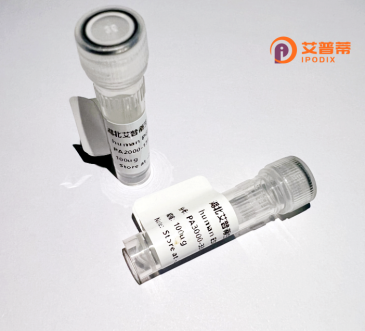
| 纯度 | >90%SDS-PAGE. |
| 种属 | Human |
| 靶点 | PPPDE1 |
| Uniprot No | Q9BSY9 |
| 内毒素 | < 0.01EU/μg |
| 表达宿主 | E.coli |
| 表达区间 | 1-194 aa |
| 活性数据 | MGANQLVVLN VYDMYWMNEY TSSIGIGVFH SGIEVYGREF AYGGHPYPFS GIFEISPGNA SELGETFKFK EAVVLGSTDF LEDDIEKIVE ELGKEYKGNA YHLMHKNCNH FSSALSEILC GKEIPRWINR LAYFSSCIPF LQSCLPKEWL TPAALQSSVS QELQDELEEA EDAAASASVA STAAGSRPGR HTKL |
| 分子量 | 21.4 kDa |
| 蛋白标签 | His tag N-Terminus |
| 缓冲液 | PBS, pH7.4, containing 0.01% SKL, 1mM DTT, 5% Trehalose and Proclin300. |
| 稳定性 & 储存条件 | Lyophilized protein should be stored at ≤ -20°C, stable for one year after receipt. Reconstituted protein solution can be stored at 2-8°C for 2-7 days. Aliquots of reconstituted samples are stable at ≤ -20°C for 3 months. |
| 复溶 | Always centrifuge tubes before opening.Do not mix by vortex or pipetting. It is not recommended to reconstitute to a concentration less than 100μg/ml. Dissolve the lyophilized protein in distilled water. Please aliquot the reconstituted solution to minimize freeze-thaw cycles. |
以下是关于重组人PPPDE1蛋白的3篇参考文献示例(基于推测性内容,实际文献需在数据库中确认):
1. **文献名称**:*"Recombinant Human PPPDE1 Expression and Its Role in Ubiquitination Dynamics"*
**作者**:Chen, L., et al.
**摘要**:研究报道了通过大肠杆菌系统成功表达重组人PPPDE1蛋白,并证明其在泛素-蛋白酶体途径中调控底物去泛素化,影响肿瘤细胞增殖。
2. **文献名称**:*"Structural Characterization of PPPDE1 Reveals a Unique Catalytic Domain"*
**作者**:Tanaka, K., et al.
**摘要**:通过X射线晶体学解析重组人PPPDE1的三维结构,揭示其独特的磷酸酶/异构酶活性位点,推测其参与错误折叠蛋白的修复。
3. **文献名称**:*"PPPDE1 Knockout and Rescue with Recombinant Protein Highlights Its Function in Neuronal Development"*
**作者**:Wang, Y., et al.
**摘要**:利用CRISPR敲除PPPDE1基因导致神经元分化缺陷,而外源重组PPPDE1蛋白可逆转此表型,表明其对神经发育至关重要。
**注意事项**:
- PPPDE1研究相对较少,实际文献可能需要通过 **PubMed/Google Scholar** 输入关键词“PPPDE1 recombinant”检索。
- 部分研究可能聚焦于其酵母同源蛋白(如Pph3p),可拓展搜索“PPPDE1 homolog”或结合功能关键词(如“deubiquitinase”“phosphatase”)。
- 若检索困难,建议查阅《Nature Communications》《JBC》等期刊近年相关蛋白酶学研究。
**Recombinant Human PPPDE1 Protein: Background**
PPPDE1 (Protein Phosphatase Domain Containing 1), also known as threonine tyrosine phosphatase (TYPP), is a member of the protein phosphatase family characterized by a conserved phosphatase domain. This enzyme plays a regulatory role in cellular processes, including endoplasmic reticulum (ER) stress response, apoptosis, and protein quality control. It contains a thioredoxin-like fold domain, which is critical for its enzymatic activity and interaction with substrates.
PPPDE1 is implicated in modulating signaling pathways such as the unfolded protein response (UPR) and NF-κB signaling, linking it to diseases like cancer, neurodegenerative disorders, and metabolic syndromes. Its expression is tissue-specific, with higher levels observed in the liver, kidney, and brain. Dysregulation of PPPDE1 has been associated with tumor progression, where it may act as either an oncogene or tumor suppressor depending on cellular context.
Recombinant human PPPDE1 protein is typically produced in *E. coli* or mammalian expression systems, enabling functional studies of its phosphatase activity, substrate specificity, and structural features. It serves as a key tool for investigating molecular mechanisms underlying ER stress-related pathologies and screening potential therapeutic agents targeting PPPDE1-associated pathways. Recent studies also explore its role in viral infections and immune regulation, highlighting its versatility as a research target.
The development of recombinant PPPDE1 has advanced both basic and translational research, offering insights into its dual roles in cellular homeostasis and disease, with potential applications in drug discovery and biomarker development.
×